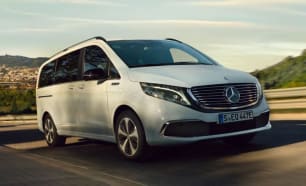If space is what you want, space is what you’ll find in the EQV. People movers like the Kia Carnival are incredibly spacious, but they can’t compete with something that’s spawned from a commercial vehicle platform, like this Benz.
Thanks to the flat floor and 2+2+3 three-row seating layout, you can literally stand up (depending on your height) and walk from the driver’s seat to the third row.
Back up front, the old underpinnings mean no fully digital instrument cluster here, just analogue dials, which is not a bad thing.
That also means the air con controls are separate from the central screen and therefore easy to use.
The MBUX system isn’t as advanced as the version fitted to the latest Benz models, and as a result there are fewer functions and it’s less complicated to use. There’s a touchpad as well as the touchscreen but I only ever used the screen.
Another slightly old school element to the EQV is the fact that it requires a key to start. Which is unusual for an EV. Also, the ignition is on the left side of the steering wheel which is great news for left-handed people but it’s somewhat annoying if you’re right-handed.
Storage wise up front, there is a decent space with a cover under the centre stack, housing cupholders, two USB-C ports and a 12-volt charger, but no wireless charger. There’s ample space for very large bottles in the front doors and it has a medium-sized glove box.
The front leather seats with fold-down armrests on each side are well bolstered and are very comfortable, too. No complaints there.
Given this car is designed to ferry people around, you’d hope for a functional rear cabin and on that Benz has delivered - for the most part.
Unsurprisingly given the EQV’s massive dimensions, there is a huge amount of headroom, legroom, and hip and shoulder room in all rows.
Both sliding side doors are power operated and one (the passenger side) can be opened via the key fob. The very large tailgate is also power operated.
Those two second-row captains chairs are comfy and supportive. There are map pockets on the rear of the front and second-row seats. There are floor and roof-mounted air vents, but just roof vents in the third row.
There’s not a whole lot of storage options in the second row, while the third row has stand-up phone holders, but that’s about it. No USB ports back there.
If you’re folding the second row seats, they’re quite heavy and cumbersome. But tumbling them forward via the lever is much easier. That ensures ample space to get into the third row.
The third row can be folded flat as well but you have to remove the very large and heavy parcel shelf from the cargo area. Like the seats the shelf structure is also on rails and it lifts out if required. That third row can also slide but not as far as the second row.
The shelf can double as a stand-up desk for a computer in the rear if required. It’s actually quite handy.
And it helps hide items in the boot. It comes with plastic folding shopping crates.
Benz says the boot can swallow 1030 litres with all seats in place, but minus the parcel shelf. It also has a 17-inch spare steel wheel under the rear of the vehicle.

